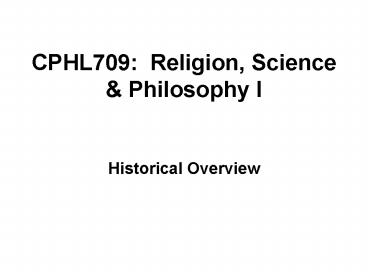CPHL709: Religion, Science PowerPoint PPT Presentation
1 / 8
Title: CPHL709: Religion, Science
1
CPHL709 Religion, Science Philosophy I
- Historical Overview
2
- 0. Medieval Period
- Popularly thought of as Dark Ages, but really
prepared the ground for the Scientific Revolution
of 16th-17th centuries - Translation of Aristotle into Latin
- Establishment of great European Universities
(though focus was not on the natural sciences,
originally) - Emergence of theologian-natural philosophers
(e.g. Henry of Lagnestein) who saw study of
nature as theologically legitimate activity -
study of works and wonders of God - Development of sophisticated ways of interpreting
the Bible non-literally laid ground for
compatibility of religion with growing scientific
accounts of the world
3
- 1. The Copernican Revolution
- geocentrism The view that earth is at centre of
the universe, and all heavenly bodies rotate
around the earth in perfect circles. (associated
with Ptolemy, 2nd Century, Egypt) - Copernicus (1473-1543) defended heliocentrism.
He argued that the apparent motion of stars and
planets is due to motion of earth (rotation on
axis, and rotation around sun) - Johannes Kepler (1571-1630) refined Copernican
theory with introduction of elliptical orbits.
4
- Conflict The geocentric model was accepted by
theologians throughout the medieval period, and
seemed to fit well with the Genesis worldview. - One solution Calvinist Accommodationist
approach Revelation comes to people in a form
they will understand - we must understand
Biblical revelation as intended for a
scientifically unsophisticated audience. - The main topic of Biblical revelation is the
salvational message of Jesus Christ for humanity.
The bible was never intended as a scientific
treatise.
5
- 2. The Newtonian Revolution
- Newtons essential contribution was the
demonstration of the universality of science
that the entire cosmos - the heavens and
earth, so to speak - operates according to
the same basic laws. - All objects great and small, earthly and
heavenly, behave according to the same few
principles of motion. - The Mechanistic worldview the universe is like
a big machine, regulated by the laws of motion. - Things dont just happen by chance rather, they
occur in an orderly, in principle predictable
manner.
6
- Newtonian Mechanism can motivate a variety of
religious responses. A couple of prominent ones - Deism An appealing religious alternative in the
age of Newton Belief that God is the designer
and creator of the universe, but is not
continually, personally involved with it. God is
an aloof architect who creates a law-governed
universe that runs on its own. - Atheism Since the universe is a self-contained,
self-sustaining entity whose nature can be
understood without reference to God, why retain
belief in God? - I have no need of that hypothesis.
- -attributed to LaPlace, but probably
- apocryphal)
7
- 3. The Darwinian Revolution
- According to the literal Genesis picture of
humanity, we were created directly by God, after
all other species, as the culmination of Gods
creative efforts. - According to Darwinian theory, we share a common
ancestry with all life on Earth, having evolved
very slowly, through a blind natural process. - Evolution presupposes Deep Time - that the
Universe is exponentially older (13.7 billion
years, by current calculations) than the literal
Biblical view (perhaps 6,000 years old) would
have it, and humans have not existed for most of
that time.
8
- Notice the decentering effects that each of
the three scientific revolutions has on our place
in the cosmos - 1. Copernican Revolution
- Earth and thus humans are physically peripheral,
not central in the universe. - 2. Newtonian Revolution
- The earth and life on it are not physically
special in any deep way they obey the same
mechanistic laws that govern all of the universe. - 3. Darwinian Revolution
- Humans share a common ancestry with all life on
earth. - We are temporally off-centre - we come into
existence very late in the history of the universe

